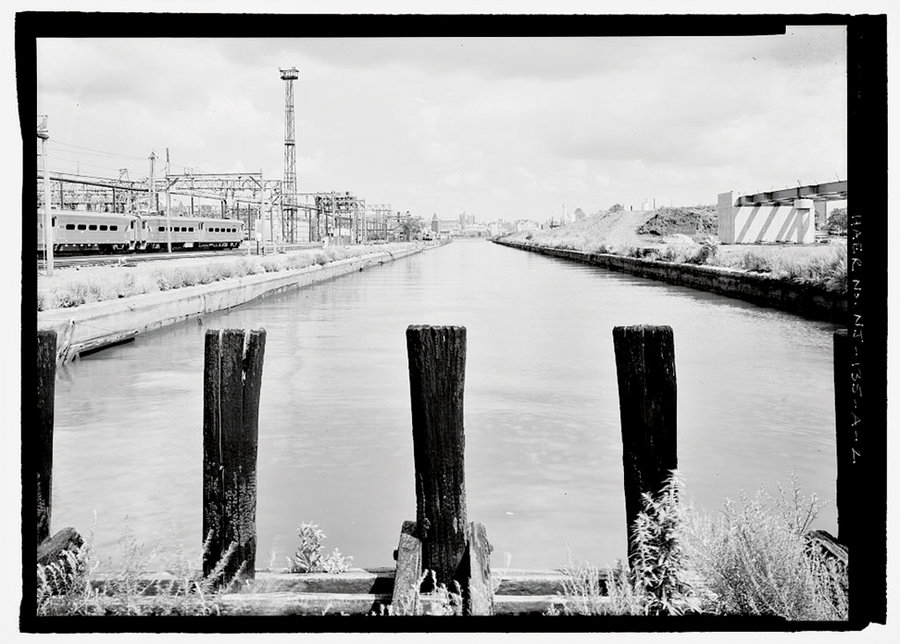A recent public symposium regarding $230 million in federal flood mitigation aid for Hoboken and its neighbors made at least one thing clear: choosing how to spend the money will be a massive intergovernmental undertaking.
At the Jan. 20 meeting, Hoboken Mayor Dawn Zimmer and Weehawken Mayor Richard Turner were joined by representatives from Jersey City, the North Hudson Sewerage Authority, Rebuild by Design, the U.S. Department of Housing and Urban Development, and the New Jersey Department of Environmental Protection (DEP).
One agency conspicuously absent from the gathering was NJ Transit. The new federal grants, won in the Rebuild by Design competition last June, will primarily fund flood barriers, and NJ Transit’s low-lying Hoboken rail yards were one of two key entry points for the Hurricane Sandy storm surge.
In particular, Long Slip Canal, a defunct freight barge canal the length of five football fields that adjoins the rail yards, launched the floodwaters into Hoboken’s interior.
NJ Transit has promised to fill the canal, but despite past collaborations with Hoboken’s Rebuild by Design team, their project does not fall under the purview of DEP, which will control the Rebuild money. Last September, NJ Transit received its own $146 million grant from the Federal Transit Administration (FTA) to harden the canal.
Common ground with city
NJ Transit’s Long Slip funding was part of a $1.5 billion tranche of transportation-specific Sandy resiliency grants awarded to New Jersey last year. The money will also cover fortifications to the aboveground elements of the Exchange Place, Newport, and Grove Street PATH stations.
NJ Transit’s decade-long pursuit of large-scale mixed-use development in the Hoboken rail yards has produced an at-times adversarial relationship with the city of Hoboken. But on the issue of flood mitigation, they appear to have found common ground.
“It’s not the panacea that’s going to solve south Hoboken’s problems, but everything helps.” – Alan Blumberg, Stevens oceanographer
____________
In his letter, Leon said that NJ Transit’s canal plans would be “consistent” with OMA’s design.
“NJ Transit staff has held a series of meetings with the OMA team,” wrote Leon, “providing OMA with technical data, drawings and other support as OMA has worked through the Rebuild by Design Process.”
High concept
In its press release announcing the FTA funding, NJ Transit says it will “fill the canal to an elevation above the Federal Emergency Management Agency base flood elevation.”
Base flood elevation denotes the expected height of a “100-year-flood” – one with a 1 percent chance of occurring each year – above sea level.
What exactly this will mean for the Long Slip remains unclear. Asked for specific heights, NJ Transit spokesman William Smith referred The Hoboken Reporter to the most recent FEMA flood maps, which show a base flood elevation of 16 feet at the canal’s mouth and 11 to 12 feet along most of its length.
A 16-foot-plus bulwark at the head of the canal would be in keeping with Hoboken’s Rebuild by Design proposal, which recommended roughly the same flood defense height. Interestingly, the proposal’s figures were based on a 500-year-flood, plus 2.5 feet of sea level rise and an extra foot to account for waves.
Smith said the exact height of the filled canal would be determined in the final design. Engineering firm URS Corporation has been hired as a “third-party service” for the project, which is currently in the concept design phase.
Not a panacea
No matter the final height, it will undoubtedly stand above the rest of the rail yards, which lie below FEMA base flood elevation. Besides some power substations, Smith said NJ Transit has no plans to raise the rest of its property, including the Warrington Plaza just north of the terminal, another significant flood entry point.
According to Alan Blumberg, an oceanographer at the Stevens Institute of Technology, filling the Long Slip Canal above base flood elevation would reduce floodwater depths throughout Hoboken by an estimated 6 to 10 inches. “It’s not the panacea that’s going to solve south Hoboken’s problems, but everything helps,” he said.
Blumberg mentioned that a flood wall at the front of the canal would have the same effect as filling it in completely.
“All you have to do is block the Hudson River,” said Blumberg. “You really didn’t have to fill the whole thing in if you didn’t want to.”
But NJ Transit has plans for the reclaimed space. It has proposed building six new commuter rail tracks with ADA-accessible platforms on the area.
The elevated position of these tracks and platforms will permit the rapid recovery of commuter rail services to and from Hoboken Yard, even while the main yard infrastructure and equipment is taken out of service for an impending storm, according to an NJ Transit press release.
Carlo Davis may be reached at cdavis@hudsonreporter.com.
